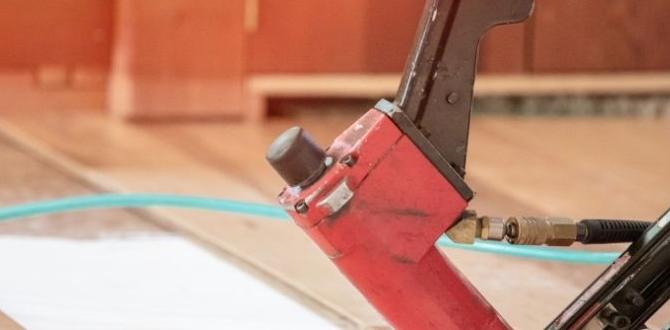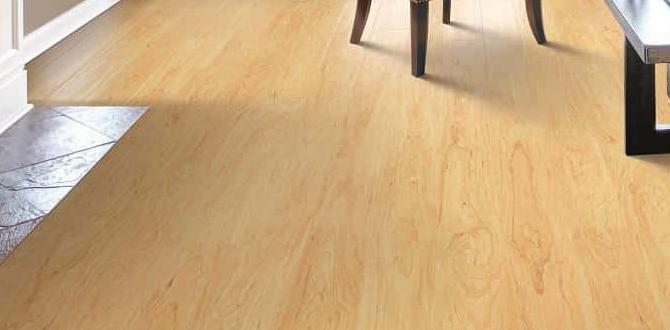Quick Summary:
Choosing the right shank type is essential for secure and effective fastening. It ensures your tool grips fasteners properly, preventing slippage and ensuring a strong hold for any DIY project. We’ll break down the common types to help you pick the perfect match.
Hey there, DIYers! Jack Shaffer here from Nailerguy. Ever stared at a box of screws or nails and wondered why one type just feels ‘right’ for your tool, while another feels… off? That’s likely down to the shank! The shank might seem like a small detail, but it’s a crucial part of how your fasteners work with your tools. Getting it wrong can lead to stripped heads, damaged materials, and a whole lot of frustration. But don’t worry! This guide is here to demystify shank types and help you confidently choose the absolute best for your next project. We’ll walk through what they are, why they matter, and how to pick the right one, every single time.
Table of Contents
What Exactly is a Shank? The Unsung Hero of Fasteners
Let’s start with the basics. When we talk about a fastener, like a nail or a screw, the shank is the long, slender part that connects the head to the tip. Think of it as the fastener’s body. It’s what drives through your material and holds everything together. While it might look simple, the design of the shank is incredibly important for its function.
Different tools, especially nail guns and impact drivers, are designed to work with specific shank types. The way the shank is shaped dictates how securely it’s held by the tool’s driver bit or nail head, and how it penetrates and grips the material. Believe me, understanding this can save you a world of trouble and lead to much better results on your projects.
Why Does Shank Type Even Matter for Your DIY Projects?
You might be thinking, “It’s just a nail/screw, how much difference can the shank make?” The answer? A huge difference! The shank type directly impacts:
- Tool Compatibility: Many nail guns and screw guns are designed with specific drivers that only accept certain shank shapes. Using the wrong type can lead to jams or damage to your tool.
- Holding Power: Different shank designs offer varying levels of grip and withdrawal resistance in wood or other materials. Some are smooth for easier driving, while others are textured or have rings for extra strength.
- Preventing Damage: A properly matched shank means less slippage. Less slippage means fewer stripped screw heads, fewer bent nails, and no gouges in your beautiful workpiece.
- Driving Efficiency: The right shank type allows your tool to drive fasteners smoothly and efficiently, saving you time and battery power.
So, while it seems small, choosing the correct shank type is really about ensuring your tools work as they should and your fasteners do their job effectively and cleanly. It’s a foundational step toward professional-looking results, even for us DIYers!
Common Nail Shank Types: Grip and Go!
Nails come in various shank types, each designed for specific applications and holding power. For nail guns, this is particularly important. Here’s a rundown of the most common types you’ll encounter:
Bright Shank Nails
These are your most basic, common nails. They have a smooth shank and no coating. They’re inexpensive and good for general-purpose interior work where rust isn’t a concern.
- Pros: Very common, affordable, easy to drive.
- Cons: Prone to rust, not suitable for exterior use or treated lumber.
- Best For: Interior framing, DIY projects that won’t be exposed to moisture.
Electro-Galvanized Shank Nails
These nails have a thin coating of zinc applied through an electrolytic process. This coating offers some resistance to corrosion, making them suitable for many exterior applications and use with treated lumber.
- Pros: Offers moderate rust resistance, good for treated wood.
- Cons: Coating can be thin and may wear off with aggressive driving.
- Best For: Exterior trim, fencing, decks, and general construction.
Hot-Dip Galvanized Shank Nails
These nails are dipped in molten zinc, creating a thicker, more durable coating than electro-galvanized nails. This provides excellent protection against rust and corrosion, making them ideal for any outdoor project or applications involving harsh chemicals.
- Pros: Excellent rust and corrosion resistance, ideal for harsh environments.
- Cons: Can be bulkier due to the thick coating; might be slightly more expensive than electro-galvanized.
- Best For: Heavy-duty exterior projects, docks, foundations, and anything needing long-term weather protection.
Stainless Steel Shank Nails
Made from stainless steel, these nails offer the best corrosion resistance. They are particularly useful in environments with high moisture or exposure to salt, like coastal areas or marine applications. They are also non-magnetic and non-staining.
- Pros: Superior rust and corrosion resistance, non-staining.
- Cons: Most expensive option, can be harder to drive than other types.
- Best For: Coastal areas, marine construction, food-grade applications, or any project where rust is absolutely not an option.
Ring Shank Nails
These nails have horizontal rings encircling the shank. These rings essentially cut into the wood fibers as the nail is driven, creating a much stronger grip and significantly increasing withdrawal resistance. They are excellent for applications where vibration or stress might loosen fasteners.
- Pros: High holding power, resists withdrawal and vibration.
- Cons: Can be harder to drive, may leave a slightly larger entry hole.
- Best For: Subflooring, framing, roofing, and any structurally critical applications where fasteners need to stay put.
Screwy Shank Nails (or Spiral Shank)
Resembling screws, these nails have a spiral pattern on their shank. This design helps them bore into lumber and provides a good balance between ease of driving and holding power. They offer better resistance to pull-out than smooth shank nails but are generally easier to drive than ring shank nails.
- Pros: Good holding power, easier to drive than ring shanks, provides moderate resistance to pull-out.
- Cons: Not as strong as ring shank or screws for holding power.
- Best For: Decking, wooden fencing, and general construction where good holding power is needed but ease of driving is also a factor.
Common Nails vs. Finish Nails: A Quick Comparison
It’s also worth noting the difference between common nails and finish nails, as their shanks are very different:
- Common Nails: These are typically thicker with a larger head and a smooth shank. They are strong and designed for structural applications like framing.
- Finish Nails: These are much thinner with a small head and a smooth shank. They are designed to be less visible after driving, making them ideal for trim work, molding, and cabinetry. They offer less holding power than common nails.
Common Screw Shank Types: The Grip You Need for Impact
Screws provide superior holding power compared to nails, and their shank design is a big reason why. For power tools like impact drivers and drills, the shank is paramount to getting a clean drive and a secure fit.
Smooth Shank Screws
Many screws, especially those designed for wood, have a smooth shank section just below the head. This is a crucial design feature. When you drive a screw, the threads pull the screw into the material. The smooth shank allows the screw to pull pieces of wood together tightly without the threads trying to bore deeper into the second piece. This is essential for creating strong joints.
- Pros: Allows for strong clamping of materials, easy driving until threads engage.
- Cons: Holding power depends entirely on the threads.
- Best For: Joining two pieces of wood where you want them compressed tightly.
Threaded Shanks (Fully Threaded Screws)
These screws have threads that run all the way from the tip to just under the head. They are designed to grip strongly into the base material. They are excellent when you need maximum holding power in a single piece of material or when driving into softer materials where the threads can really engage.
- Pros: Excellent holding power in the material.
- Cons: May not pull materials together as effectively as screws with a smooth shank section.
- Best For: Attaching hardware, anchoring into drywall (with appropriate anchors), or when maximum thread engagement is needed.
Washer Head Screws
These screws have an integrated washer beneath the head. This washer acts as a larger bearing surface, preventing the screw head from punching through softer materials and distributing the clamping force over a wider area. The shank below the head can be smooth or threaded depending on the screw’s specific application.
- Pros: Distributes load, prevents pull-through on soft materials.
- Cons: Can be bulkier, may not be suitable for all aesthetics.
- Best For: Attaching metal to wood, securing plastic components, or anywhere a wider bearing surface is beneficial.
Machine Screws
Machine screws are designed to be used with nuts or tapped holes. They have a smooth shank and threads designed to engage precisely with a nut or threaded insert. They offer a very strong and secure fastening, often found in mechanical assemblies or when you need to repeatedly fasten and unfasten components without damaging the threads.
- Pros: Excellent for mechanical assemblies, reusable, strong.
- Cons: Requires a matching nut or threaded hole, not for direct use in wood.
- Best For: Joining pre-drilled parts, appliance repair, electronics.
Shank Types for Specific Tools: Power Up Wisely!
The type of fastening tool you’re using often dictates the shank type you should be looking for in your fasteners. This is especially true for nail guns and impact drivers.
Nail Gun Compatibility
Nail guns are designed to accept nails based on their collation (e.g., coil nails, stick nails) and, importantly, their shank type. The driver blade in your nailer is shaped to strike the nail head and drive the shank. For most general framing and construction nailers, you’ll be using nails with:
- Ring Shank or Screwy Shank: For framing nails where extra holding power is needed to prevent movement and ensure structural integrity.
- Smooth Shank: For lighter duty tasks or when ease of driving is prioritized.
- Galvanized Shanks: Essential for any exterior work to prevent rust and staining.
Always check your nail gun’s manual for recommended nail types and shank specifications. For example, a framing nailer might handle ring shank framing nails, while a finish nailer will use smooth shank finish nails.
Impact Driver & Drill Compatibility
Impact drivers use rotational force and percussive blows to drive screws. This means the connection between the driver bit and the screw head (and the shank’s ability to facilitate clean driving) is critical.
- Smooth Shank Section: As mentioned, screws with a smooth shank section are excellent for impact drivers. The smooth shank allows the screw to spin freely until it seats, enabling the impact action to work effectively without over-driving or stripping the head when pulling materials together.
- Thread Design: While not strictly a shank type, the thread pitch and design on screws are also critical for impact drivers. Coarse threads are common for wood, but some specialized screws are designed for optimal performance with the high torque of impact drivers.
- Self-Tapping Screws: Many screws used with impact drivers are self-tapping, meaning they create their own threads as they drive. This works wonders in wood and some plastics.
Using screws with adequate thread engagement and the correct head type (like Phillips, Torx, or Square drive) that matches your driver bits will ensure a secure grip and efficient driving. For best results, consider impact-rated screws, which are hardened to withstand the forces of an impact driver.
Choosing the Right Shank for Your Material: Wood, Metal, and More!
The material you’re fastening into will also guide your shank choice. Different shank designs excel in different substrates:
For Softwoods (Pine, Fir, Cedar)
Softwoods are forgiving, and most shank types will work well. However:
- Smooth Shanks: Drive easily and are good for general joinery.
- Ring Shanks: Offer superior holding power if the wood is subject to movement or stress.
- Screwy Shanks: Provide a good compromise between ease of driving and holding power.
For Hardwoods (Oak, Maple, Walnut)
Hardwoods are dense and can resist fastener penetration. Pre-drilling pilot holes is often recommended. For hardwoods:
- Smooth Shanks: Still work, but may require more force or a pre-drilled hole.
- Screwy Shanks: Can be beneficial as their spiral nature helps bore into the dense wood.
- Specific Wood Screws: Look for high-quality wood screws designed for hardwoods, often with aggressive threads and a smooth shank to allow for tight pulls.
For Treated Lumber
Modern treated lumber (especially for decks and outdoor structures) often contains chemicals that can corrode standard fasteners. You’ll need corrosion-resistant shanks:
- Hot-Dip Galvanized: The go-to choice for most treated lumber projects, offering excellent protection.
- Stainless Steel: The ultimate protection, especially in very wet or coastal environments.
- Coated Screws: Many structural screws designed for treated lumber have specialized coatings that offer good corrosion resistance.
Be aware that new ACQ-treated lumber, for instance, is more corrosive than older CCA-treated lumber. The ICC-ES AC271 report on fasteners and treated wood highlights the importance of appropriate coatings and materials.
For Metal and Other Materials
When fastening metal to metal or metal to wood, you’ll typically use screws designed for these specific applications. These often have specialized thread forms and may include self-drilling tips (like Tek screws) or machine screw threads. Shank type here is less about grip in the material and more about the shank’s profile and thread engagement for the specific application.
Shank Finishes and Their Impact
Beyond the shape, the finish on a shank is important, especially for nails used in specific environments or with certain wood types. We touched on galvanizing, but let’s recap the main finishes:
- Uncoated (Bright): No protection, prone to rust. Use indoors only.
- Electro-Galvanized: Light zinc coating for moderate corrosion resistance. Good for some exterior use and treated lumber.
- Hot-Dip Galvanized: Thick zinc coating for excellent corrosion resistance. Ideal for all outdoor projects and treated lumber.
- Vinyl Coated: A layer of vinyl over the shank. Often used for specific applications, like hidden deck fasteners, to prevent corrosion and staining.
- Stainless Steel: Naturally corrosion resistant. The most durable and best for harsh environments.
- Porcelain Enamel: A glazed coating, often found on roofing nails, providing excellent weather resistance.
The finish ensures your fastener lasts and doesn’t stain or degrade your project materials, which is a huge aesthetic win for any DIYer.
Tables: Quick Shank Type Comparison
To help you visualize and compare, here are some tables summarizing key shank types and their applications.
Table 1: Common Nail Shank Types at a Glance
This table provides a quick overview of popular nail shank types for DIYers.
| Shank Type | Description | Primary Use | Holding Power | Corrosion Resistance |
|---|---|---|---|---|
| Bright | Smooth, no coating | Interior general carpentry | Low | None |
| Electro-Galvanized | Thin zinc coating | Exterior trim, general exterior | Low to Moderate | Moderate |
| Hot-Dip Galvanized | Thick zinc coating | Heavy-duty exterior, treated lumber | Moderate | High |
| Ring Shank | Concentric rings on shank | Framing, subflooring, high-stress areas | Very High | Depends on finish (e.g., galvanized) |



